Are you looking to ditch commercial detergent and toxic chemicals and use a natural soap instead? This simple powder laundry detergent is for you. It’s made with simple ingredients, takes just 5 minutes, and is the hardest working homemade detergent-fighting stains and odors like a champ.
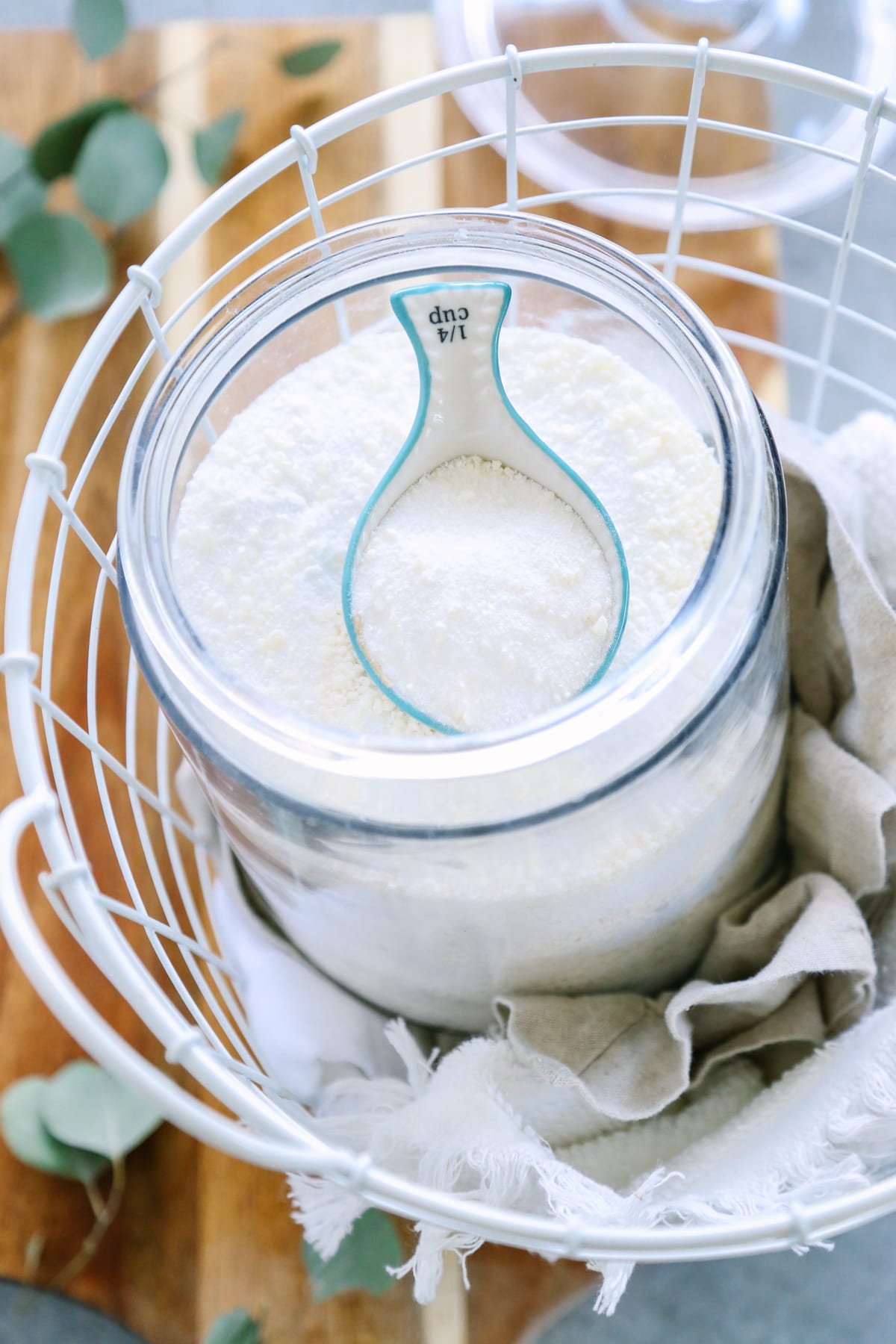
Want to Save This Article?
Enter your email & I’ll send it straight to your inbox. And you’ll get new recipes & tips each week.
I’ve been using this powder laundry detergent recipe and DIY liquid detergent for over 11 years, and my laundry always smells and feels fantastic.
Homemade Powder Laundry Detergent Benefits
- Natural Laundry Soap Recipe – No harsh chemicals in this detergent. You only need 2 bars of natural soap, borax, and washing soda.
- Save Money – Not only is making your detergent a great way to reduce toxic chemicals, it’s also a great way to save money.
- Clean Laundry – The natural ingredients clean clothes, eliminate odors, and even remove tough stains.
- Quick & Easy – This recipe takes about 5 minutes to make.
- 56 Loads of Laundry – Plenty of detergent for a family.
- 12-Month Shelf Life – Store the detergent in a container for up to a year.
Before You Get Started: What You’ll Need
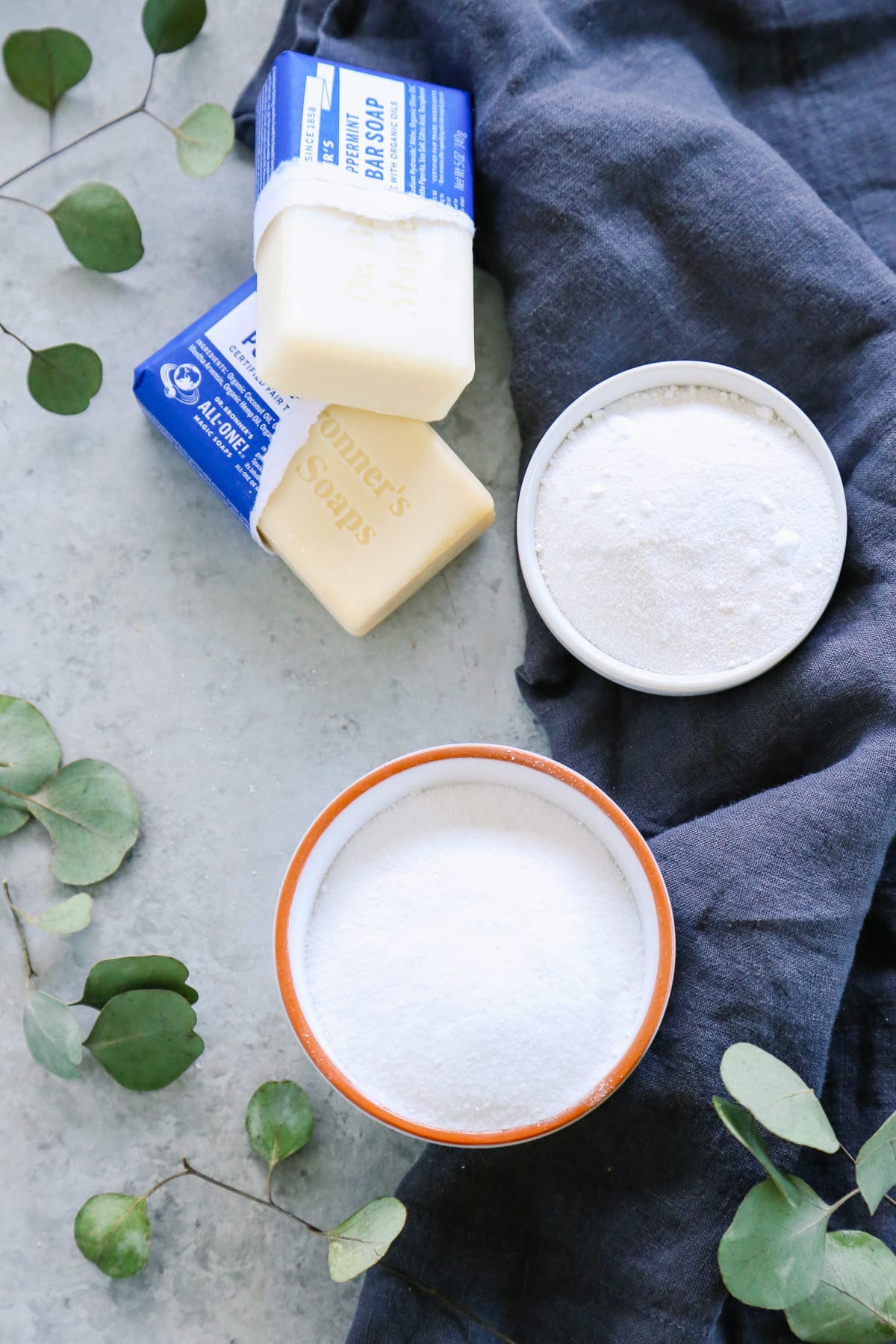
Ingredients
- 2 5-oz castile soap bars – Cleans, removes dirt and grime, fights against stains, and freshens. Castile soap is a plant-based, concentrated soap. It’s the best option for making your own laundry detergent. Dr. Bronner’s brand is easy to find in the grocery store (body/beauty aisle) and has over 20 uses. I also use castile soap to make liquid laundry detergent.
- 3 cups washing soda – Boosts the power and effectiveness of the soap, helping to remove stains and eliminate odors. Also called “soda ash.”
- 2 cups borax – Laundry softener and water conditioner. Boosts the cleaning power of the soap, removes odors, and fights tough stains.
- 30 drops essential oil of choice (Optional) – For a subtle scent. My favorite essential oils for homemade laundry soap are orange, lemon, eucalyptus, lavender, and peppermint. (How to use essential oils for natural cleaning)
Equipment
- Food Processor – To grate the castile soap bars. Alternatively, use a cheese grater and a large bowl.
- Storage Container – Choose a storage container holding at least 6 cups of dry powder.
How to Make Laundry Powder Detergent: Recipe Steps
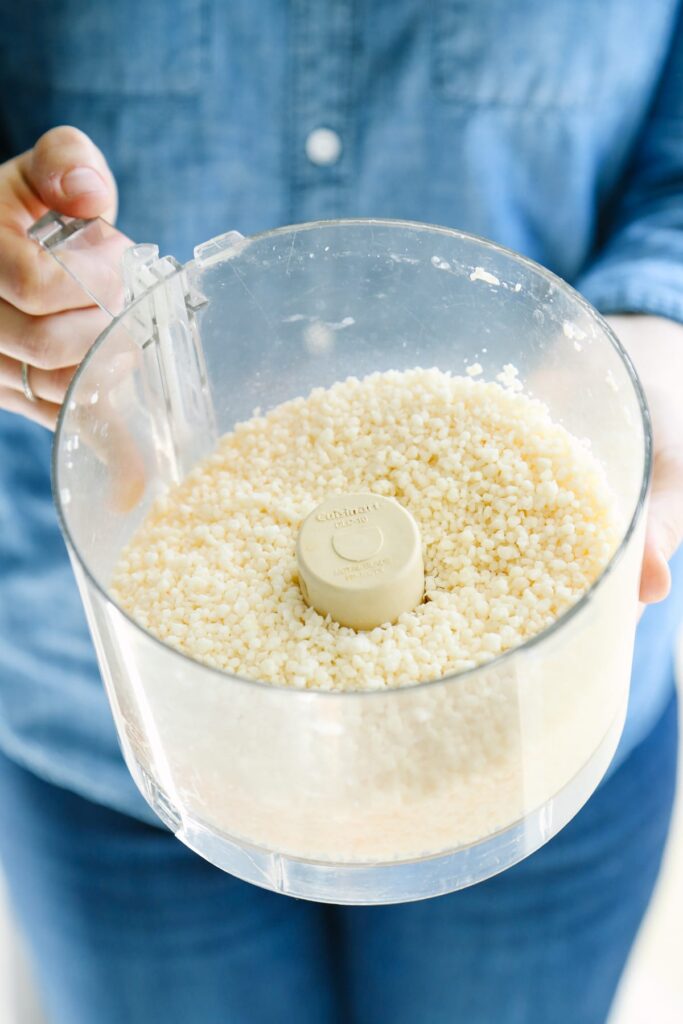
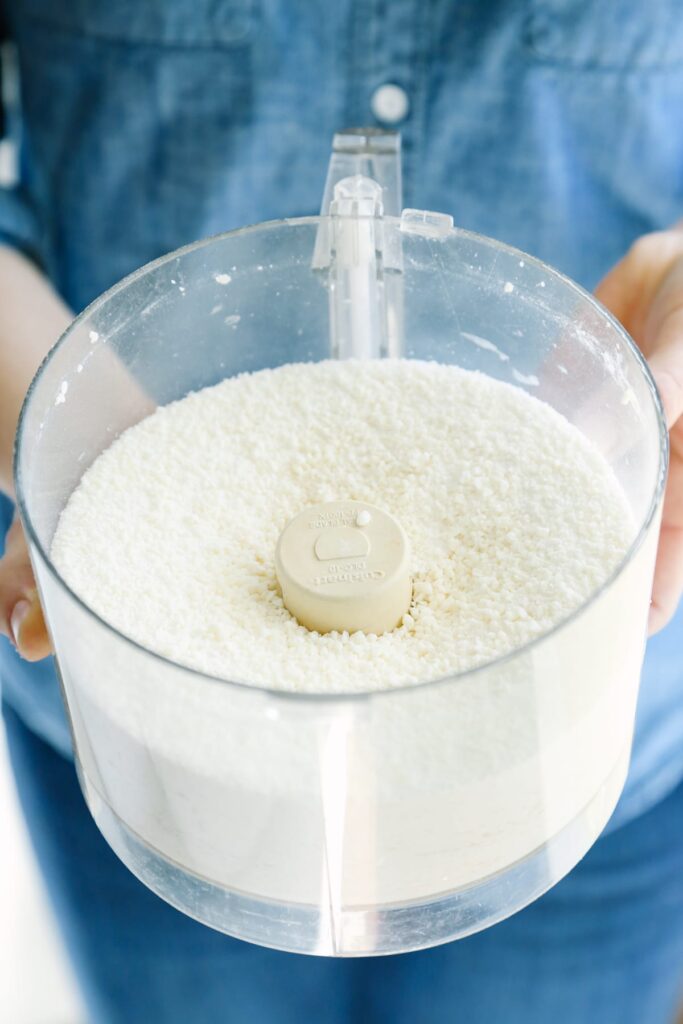
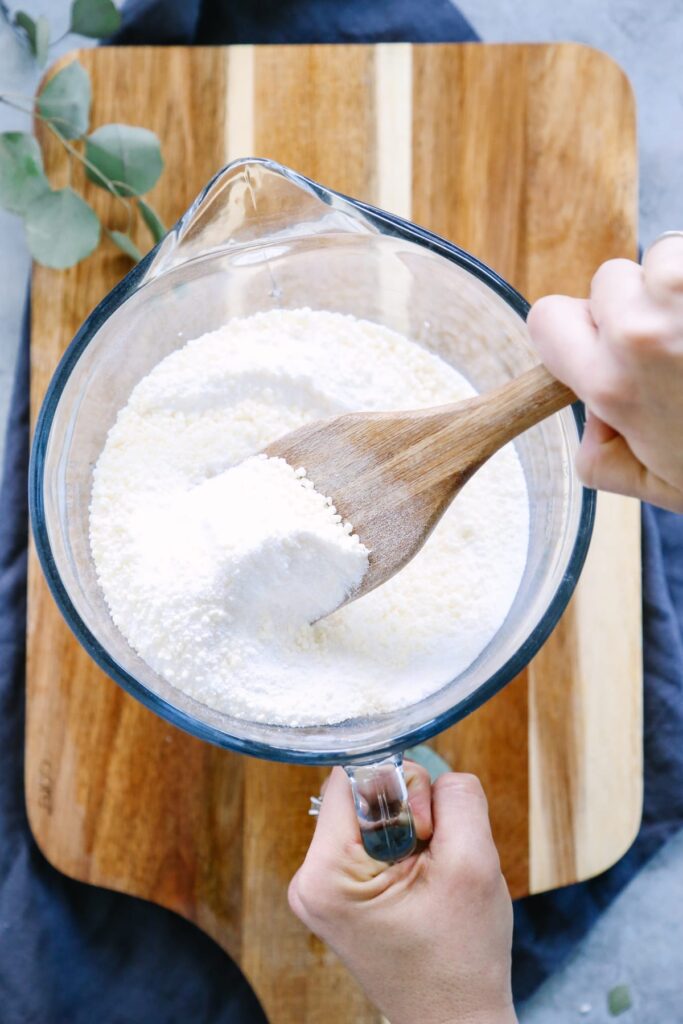
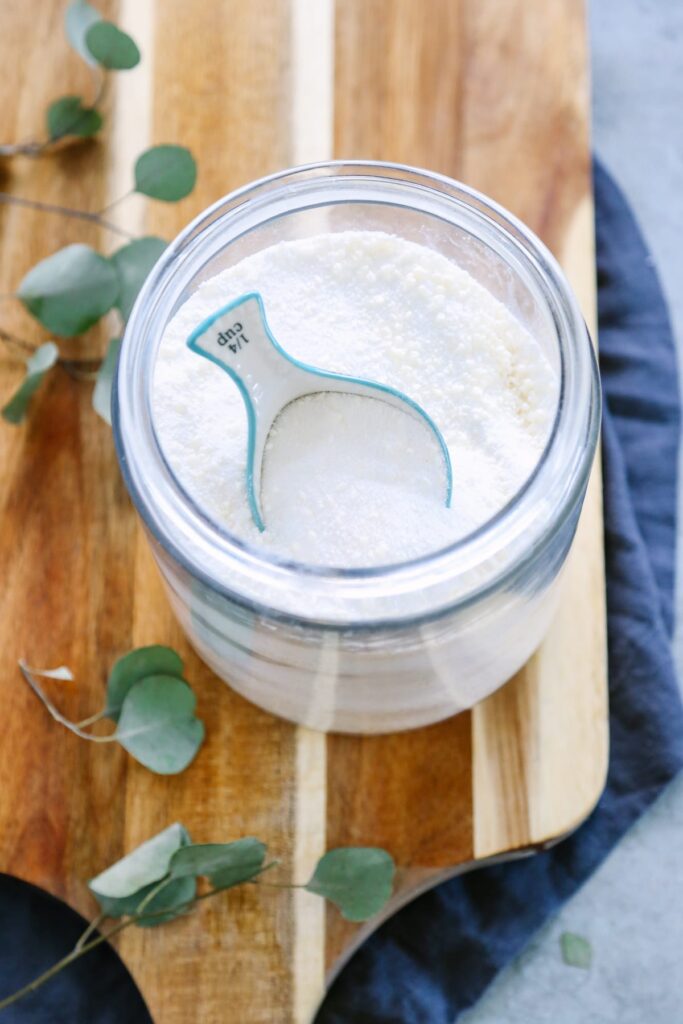
- Step 1 Cut & Grate Soap Bars – Cut the castile soap bars into small slices or chunks using a sharp chef’s knife and cutting board. Place the castile soap pieces in the food processor bowl. Pulse the soap on high until the soap resembles large crumbs (about 1 minute). If you don’t have a food processor, use a cheese grater and a large bowl.
- Step 2 Add Washing Soda & Pulse – Add 3 cups of washing soda to the food processor. Place a towel over the top of the food processor lid and pulse for 1 minute. After pulsing, the ingredients should be well combined. If you don’t have a food processor, stir the washing soda with the grated soap in a large bowl.
- Step 3 Pour Into Storage Container & Add Borax – Pour the combined washing soda and grated soap into a storage container, stir in 2 cups of borax (or seal the lid on the container after adding the borax and shake the container to combine).
- Step 4 Add Fragrance – If desired, add your favorite essential oil or a couple of essential oils to create a custom scent blend. Stir to combine (or shake the container with the lid on).
The detergent is now ready to use. Read on to learn how to use the detergent for the freshest, cleanest laundry.
Watch & Follow My Recipe Video Tutorial
How to Use DIY Laundry Detergent For Top Loaders, Front Loaders, & HE Machines
- For Top-Load Washing Machines – Add ⅛ cup of laundry powder per load directly to the washer basin/drum, then add linens or clothes. Close the lid on the washer and turn on the wash cycle of choice.
- For Front-Loaders and High-Efficiency Washing Machines – Add 1 tablespoon of laundry powder per load to the washer basin/drum, then add linens or clothes. Close the lid on the washer and turn on the wash cycle of choice.
- Adding Fabric Softener – If you want to use fabric softener, add the liquid softener (vinegar is a great option) to the softener compartment of the washing machine. If you’re using a powder softener (like this salt fabric softener), add the powder (and homemade soap) directly to the washer basin/drum, then add fabrics and wash.
What Temperature Water Should I Use?
- Cold Water Setting is Best – Most laundry detergents and soaps require water that is at least 60 degrees Fahrenheit to work (this is true for both homemade and conventional laundry detergents). The good news is that when you use the cold water setting in your washer, it’s usually a mix of hot and cold water. Hence, the water temperature reaches the ideal 60 degrees needed for a detergent to work correctly. For this reason, you can use the cold water setting without issue for both my liquid soap and this powder recipe.
- Colored Fabrics – The cold water setting is always best for colored fabrics.
- Sanitize Sheets & Towels – If you’d like to sanitize sheets, towels, and bed linens, use this laundry powder and the hot water setting.
Storage & Shelf Life
- Store the powder for up to 12 months in a sealed container.
- Store at room temperature.

How to Prevent Soap Residue on Clothes
- Avoid The Laundry Soap Dispenser – Add powder laundry detergent directly to the washing machine basin/drum. Do NOT add the powder to the laundry soap dispenser. Adding the clothes directly to the washing machine and then adding the clothes on top will ensure that water reaches the powder and dissolves it without getting caught in the folds of clothing and linens, which can leave a residue on clothing.
- Try the Laundry Soap Dispenser in Certain Machines- Every washing machine differs. If adding the powder directly to the wash basin/drum isn’t working, try adding the laundry soap to the dispenser. Some machines have a small drawer where you can move from liquid to powder, which is specifically made to help circulate the powder during the wash cycle.
- Soften Hard Water – Castile soap can leave a residue on dark fabrics if you have hard water, even after trying the tricks above. The borax in the recipe helps to soften water and should eliminate residue issues. The case may be hard water if you still have soap residue issues. You can try using an additional water softener (like white vinegar or a salt solution).
Best Essential Oil Blends For a Clean Scent
The best part about this recipe is that you can customize it to create your scent. Essential oils, a natural fragrance, offer a lovely, clean scent without the harsh chemicals and scent additives.
Here are a few of my favorite essential oil combos to create various scents (use 15 drops of each). Of course, you can also use individual essential oils, like lavender, orange, or lemon to create a fresh scent.
- Orange & Lemon
- Eucalyptus & Lemon
- Peppermint & Orange
- Rosemary & Peppermint
- Learn how to use essential oils and make homemade cleaners in this article. And listen to my in-depth podcast about using essential oils safely in the home.
Recipe FAQs
- Can I use the fels-naptha bar instead of the castile soap bar? Yes, you can. Use 2 bars fels naptha bars, grate in the food processor (or use a cheese grater and bowl), then add the remaining ingredients.
- Can I use an ivory soap bar instead of the castile soap? Yes, some recipes online use ivory soap bars instead of castile soap. I haven’t tried this substitution option, but you can test it.
- Can I use baking soda instead of washing soda? No, baking soda and washing soda have two different chemical compositions. You’ll need to use washing soda to make the best product. Washing soda is also called soda ash (source).
- Is it safe to use the same food processor used to make food to grate the soap? Yes, it is. Just wash the food processor well with soap and water after use.
- Does this recipe work with hard water? Yes, it does. See my tips above under “How to Prevent Soap Residue on Clothes” to learn more about hard water and this detergent.
- Does this recipe work in a high-efficiency washer? Yes, it does. Add the soap directly to the washer basin/drum, then add clothes and wash. Use 1 tablespoon of powder per load and the cold water setting.
- Can I make this recipe without borax? For a borax-free laundry powder, make this recipe.

The Best Natural Laundry Detergent Brands: I’ve researched and tried many different laundry soap brands and narrowed down the best 11 brands!
More Natural Products For Clean Laundry
- Stain Remover Spray – Remove tough stains with this simple formula made with castile soap, hydrogen peroxide, and lemon essential oil.
- Wool Dryer Balls – Soften laundry naturally with these easy-to-make wool dryer balls—a great alternative to dryer sheets. Add a few drops of essential oils to boost the scent in the dryer.
- Liquid Laundry Detergent – Combine castile soap, borax, washing soda, and water to make my popular liquid laundry soap.
- Powder Laundry Detergent – Make a powder variation of my popular liquid laundry soap using this simple recipe.
- Laundry Softener – Use vinegar to make this simple liquid laundry detergent.

DIY Homemade Powder Laundry Detergent Recipe
Equipment
- 1 food processor or use a cheese grater and large bowl
- 1 storage container with lid that holds at least 6 cups of dry powder
Ingredients
- 2-5 oz lavender castile soap bars any scent variety or unscented
- 3 cups washing soda also called "soda ash"
- 2 cups borax see notes below for a borax-free recipe
- 30 drops essential oil optional for scent, such as: lavender, peppermint, orange, or lemon
Instructions
- Cut & Grate Soap Bars – Cut the castile soap bars into small slices or chunks using a sharp chef's knife and cutting board. Place the castile soap pieces in the food processor bowl. Pulse the soap on high until the soap resembles large crumbs (about 1 minute). If you don't have a food processor, use a cheese grater and a large bowl.
- Add Washing Soda & Pulse – Add 3 cups of washing soda to the food processor. Place a towel over the top of the food processor lid and pulse for 1 minute. After pulsing, the ingredients should be well combined. If you don't have a food processor, stir the washing soda with the grated soap in a large bowl.
- Pour Into Storage Container & Add Borax – Pour the combined washing soda and grated soap into a storage container, stir in 2 cups of borax (or seal the lid on the container after adding the borax and shake the container to combine).
- Add Fragrance – If desired, add your favorite essential oil or a couple of essential oils to create a custom scent blend. Stir to combine (or shake the container with the lid on).
- The recipe is now ready to use.
Storage:
- Store in a container with a lid for up to 12 months at room temperature.
How to Use:
- For Top-Load Washing Machines – Add ⅛ cup of laundry powder per load directly to the washer basin/drum, then add linens or clothes. Close the lid on the washer and turn on the wash cycle of choice. For Front-Loaders and High-
- Efficiency Washing Machines – Add 1 tablespoon of laundry powder per load to the washer basin/drum, then add linens or clothes. Close the lid on the washer and turn on the wash cycle of choice.
- Pre-Treat Tough Stains – Before washing garments with tough stains, pre-treat the item with my stain remover spray. Then wash with this detergent.
Video
Notes
- For a borax-free laundry powder, make this laundry detergent recipe.
- For more homemade laundry recipes, check out my guide: How to Go Natural in the Laundry Room.

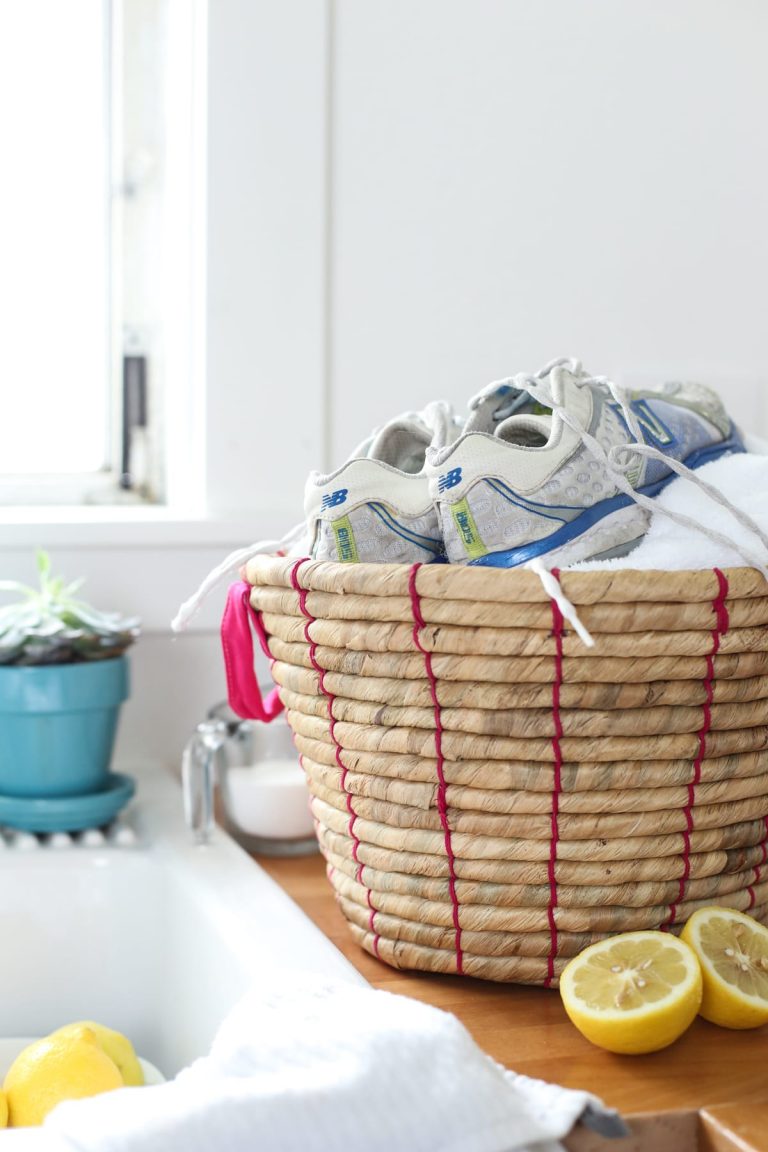
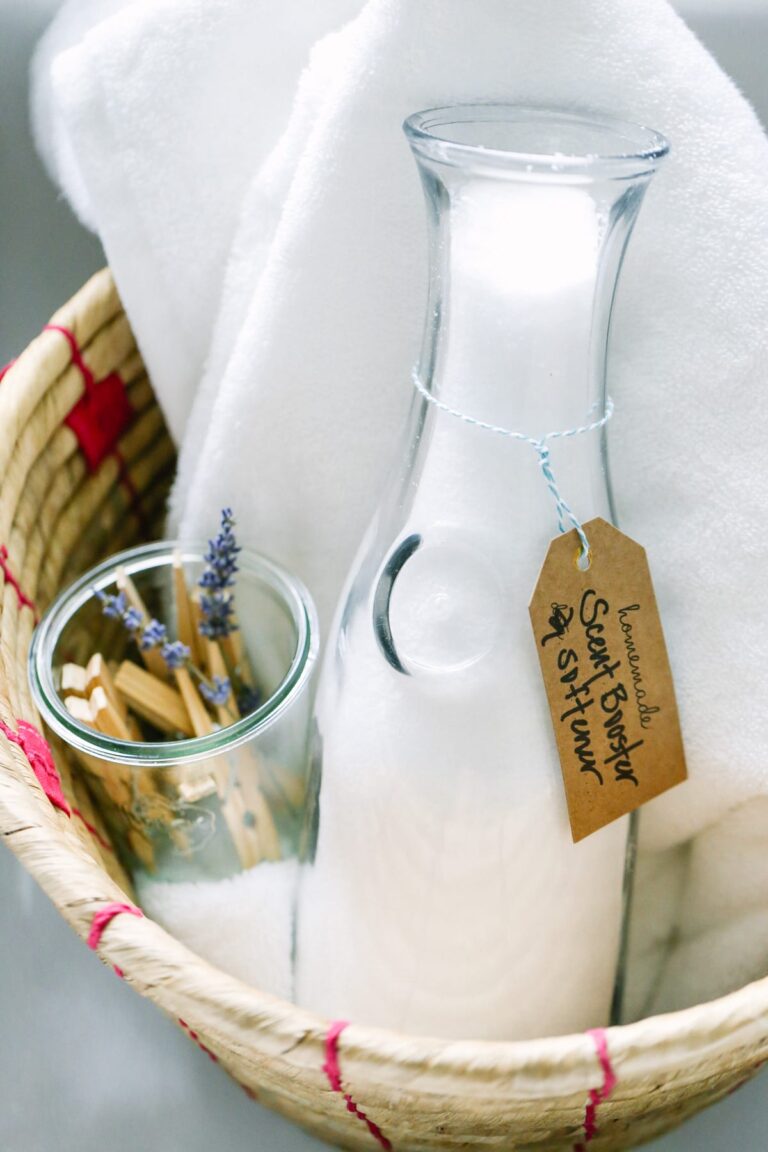

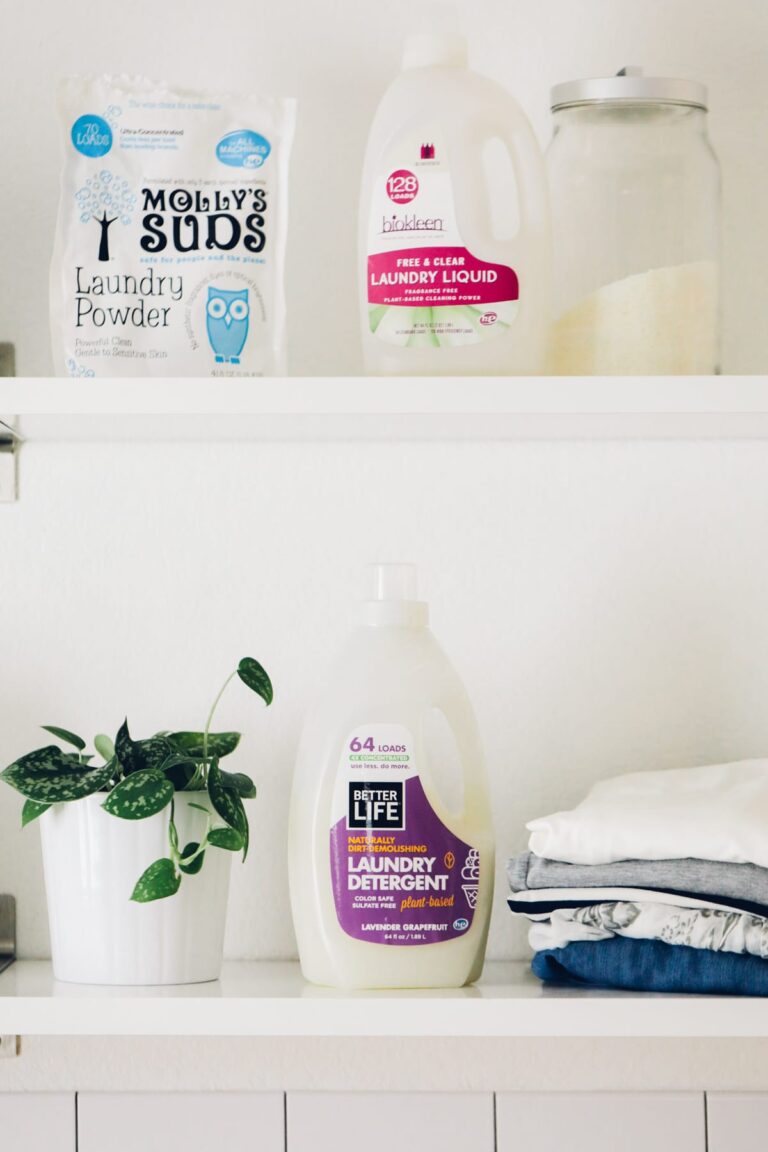
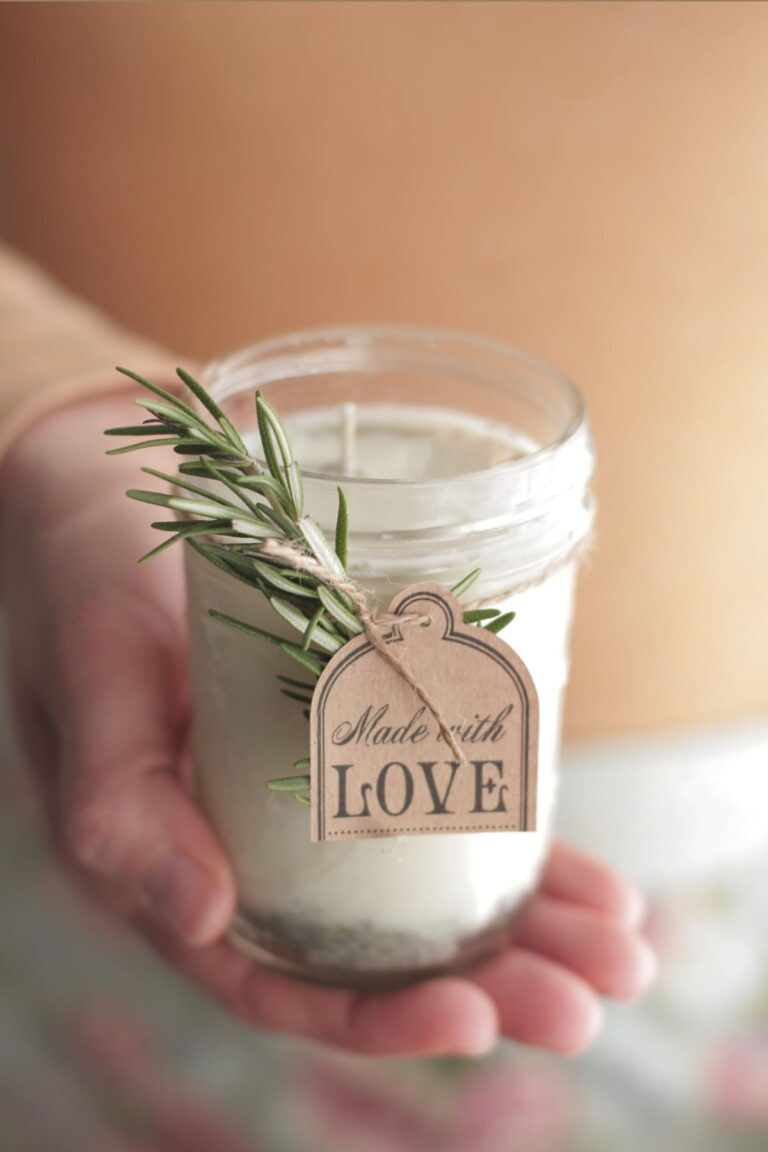
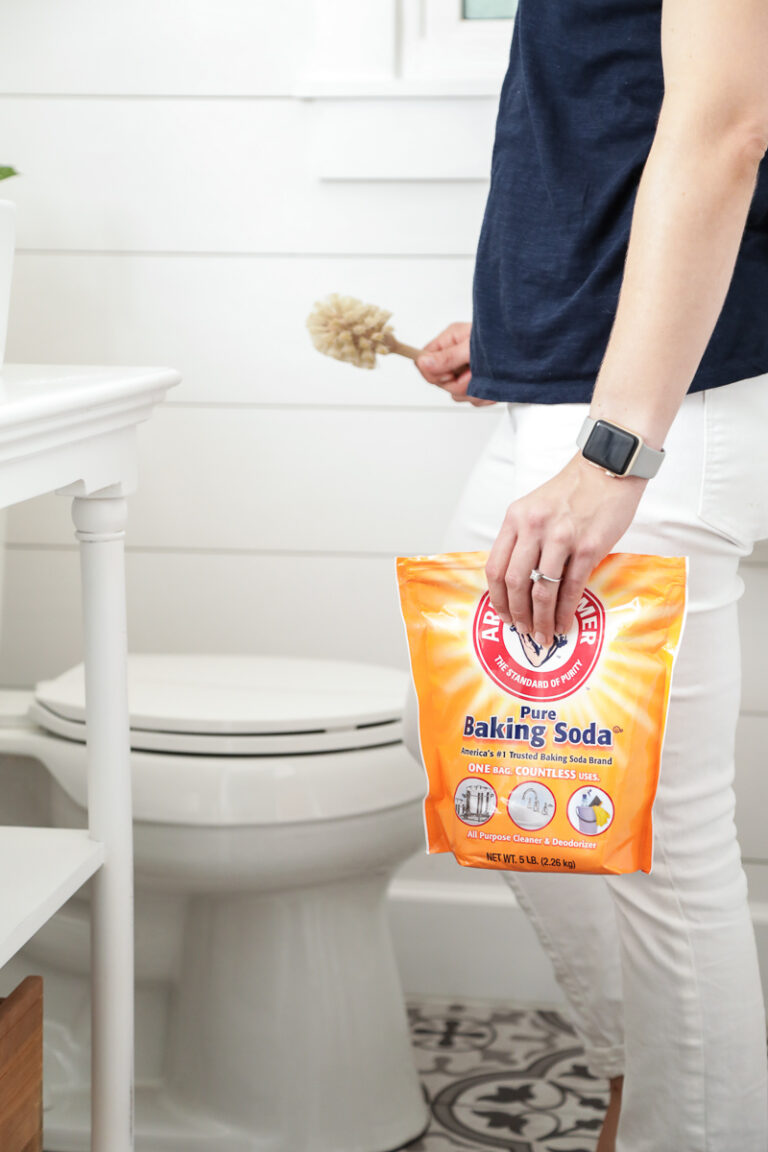
Hi Kristin, I love making and using your products. Thank you for doing all the research and development. I was noticing that my microfiber dish towels don”t do a very good job of drying dishes. The water doesn’t penetrate the fabric. Do you know why that is?
Just a quick tip. To go easier on your food processor (I use a blender) you can put first the bar of soap in the microwave for a minute or so. It puffs up in a huge souffle as the internal water goes to steam. Take it out and carefully pull apart with a fork (watch out for steam) and let cool. Now no dense chunks to challenge the blades. You can google it to see in action.
-Roman
PS you might need to wipe out microwave to get rid of soap smell before next dish goes it…
Awesome, Roman!
What could I substitute for Borax? Have tried any laundry soup without it?
I have stalked your blog for the past few weeks and I love everything about it. The DIY Cleaning is my favorite section to read and try new things. Thanks for taking the time (and fails) for finding just the right combinations.
Hey Kylie, I have and don’t care for the results without the borax. It works without borax, but it’s not as great (in my personal opinion). If you’d like to skip the borax, I recommend adding more washing soda.
Hey Kristin! Love the recipe cant wait to try it!
I see on the recipe you added essential oil, will this make the mixture less dry and instead go gluggy and sticky? I LOVE strong smelling laundry powder and only feel this will work for me if i have a scent agent too!
I blend the oils with some of the powder in the food processor, and it gets completely incorporated. No wetness or stickiness at all!
Just wondering if instead of lavendar EO it would be useful to use lavender-scented castile liquid soap? Or would that dissolve some of the powder and make it clumpy?
Hey Christy, You could use a lavender scented castile soap bar.
Hi!
I have well “hard” water has anyone had any success with hard water?
Never mind ? I just found comments about hard water!! Going to try it out!
Hi! I just tried this at the weekend with homemade bars of Castile (olive oil) soap- it worked well, although next time I might add more essential oil scent as it’s very faint. I had to grate the soap as I don’t have a food processor, but I wash at 40 degrees C and it all dissolved. Just thought if anyone wanted to know if it works with homemade soap- it does!
Awesome, Becky. Thank you for sharing.
Hi! I stumbled across your blog and can’t seem to get off of it! Hoping to try this laundry soap soon. Quick question, do you use a fabric softener at all? I currently use a store bought detergent, along with store bought softener.
Hey Katie, Welcome! When I need a laundry softener (mainly for our towels), I use vinegar or salt. Here are the recipes:
1. Vinegar: https://livesimply.me/2016/01/27/homemade-liquid-fabric-softener/
2. Salt: https://livesimply.me/2015/10/21/homemade-laundry-softener-and-scent-booster/
Hi Kristin,
I never use warm/hot water for washing clothes. Is the soap still effective? I’ve been using liquid soap nuts, which I like, but it’s on the pricey side. Thoughts?
Thanks!
Hey Tamara, I’ve found that a powder soap, like this, really needs warmer water to fully dissolve. You could try colder water and see what you think. My liquid soap works well, in my opinion, with cold water.
Hi Kristen, today while searching for great simple powder laundry soap, I found your website. I was so excited immediately, I found myself at my neighborhood store gathering the necessary ingredients to complete my new venture. Follow all the simple instructions and was finish within 10 minutes.(minus the use of a food processor) I actually used an old blender that was on its way to the Salvation Army. I also substituted the castile soap with Rose instead of your recommended choices. Now to say the lease everything went as expected. No studs, the smells was Awesome. Until the wash cycle was complete. The cloths only had slight freshness to them and about 1/2tsp of detergent was still sitting in the soap dispenser. Can you maybe help determine what could have went wrong? or if anyone else had this problem. By the way I have water purification system for the whole house. Thanks for the You tube video
Hey Christie, We just purchased a new washing machine and I’ve noticed that the same thing happens in the laundry soap “drawer.” I’ve been mixing the solution with just a tad bit of water before adding it to the drawer. I may even try placing the soap actually in the washer with the clothes. For some reason any powder is an issue for us. Hope that helps!
I’d love to use it but I wash with cold water only. Any other laundry soap recipes for cold water?
Hey Jenn, You could dissolve a bit of the powder in a cup of hot water, and then add the solution to your washer. Or you could try my liquid laundry soap: https://livesimply.me/2014/02/11/homemade-liquid-laundry-soap-all-natural-detergent/. I’ve found the hot water is necessary for dissolving the powder ingredients.
I make mine similarly. One bar of Fels Naphtha, one cup Borax, one cup washing soda. I’m just curious why you like the castile soap over the FN? I might try doubling my washing soda as in your recipe. Thank you for sharing, and I’m sorry if someone already asked this question. 🙂 Heidi
Hey Heidi, I think castile soap does a better job at cleaning, and it’s made with “cleaner” ingredients. 🙂 I haven’t researched Fels Naphtha in a while, so that may have changed.
Hi Kristin, this recipe is great as it removes odors. However, I am experiencing white sweat stains on dark color t-shirts after the laundry is done. Any ideas on how to remove these sweat stains? I love your blog.
Thank you!
Hey Cece, I’m so glad you’re enjoying the blog! I wonder if the powder isn’t fully getting dissolved in the water? I might try mixing the powder (the amount being used in the wash) with a bit of hot water first (in a cup will work), and see if that resolves the issue. If the stains remain, then it might be another issue…do you have hard water? Adding a softener might help? Let me know how it goes, and we’ll keep troubleshooting!
Is there any reason why you could not mix the powdered laundry detergent with hot water prior to adding it to the wash? That way, the solids could dissolve, but you could still wash with cold water?
Definitely, Kecia. You could try that!
I don’t use borax, but substitute Bicarbonate of Soda. This works really well.
Awesome, Susie! Thank you for sharing!
Great blog! I have been using this recipe for a month. Howeve . I use 1\2 a cup per large load. My question is this really doesn’t suds up. Does anyone complain about this?
Hey Lana, I’m so glad you’re enjoying the soap. Yes, this laundry soap doesn’t suds up like commerical laundry detergents. Most detergents add special chemicals to create the suds.
Hi!
I made the powder detergent, it was easy and fast to make! I really want to add the cleaning oil. I bought some the brand is (Tisserand) it also says aromatherapy. I don’t know if by me adding these essential oils, will affect the detergent. Should I buy an essential oil that is for cleaning? Or can I add the ones I have?
Please help!
Thanks!
Hey Sandy, I’m so glad the recipe was easy and fast for you! Yep, any essential oil you currently own will work. Some oils are known for having properties that complement a cleaning solution, like lemon or tea tree essential oil. But any essential oil should work, especially if it’s added for scent.
Do you know if this is safe for septic systems? I’d love to try it! Thanks.
Hey Annne, I’m not really sure. Let me dig around on the internet about each ingredient and its use with a septic system, and I’ll come back and comment :).
I didn’t see anything about this topic, did I miss the update? We have our own septic system as we live in the country, so I want to make sure it’s safe…especially the Castile. It always seems to leave a greasy, waxy film on my sinks when using for hand washing. Thanks for all your input!
Hi Anna,
From my research it is safe to use for septic tanks!
LS Team.
Hi, I would love to make this powder detergent, however we don’t seem to have Borax in my country, can I make it without? Or is there a substitute for it?
Hey Conny, Borax is the name brand in the States, so you might be able to find it by its scientific name: sodium borate, sodium tetraborate or disodium tetraborate. If not, adding extra washing soda will work, but it won’t provide the same cleaning power.
Hey Kristen!
I was curious: I have cloth diapers and am hoping to use a homemade powder detergent on them. I have read (but not experienced) that bar soaps (castile) aren’t ideal for cloth diapering. Have you had experience using this “recipe” on cloth diapers, or do you know someone who has?
Hey Maria, I don’t have any experience using this recipe on cloth diapers. I googled “castile soap cloth diapers” this morning and found this post: http://www.measuringflower.com/2013/08/homemade-allnatural-cloth-diaper-detergent/. It looks like a similar recipe, but she does skip the castile soap. I know there a couple of natural oxi-clean brands on the market, I think BioKleen makes one. So maybe this is a better option?
Sounds good. I had already purchased what I needed to make this recipe – and I am so tempted to just try it on my diapers – but don’t want to risk the adverse affects. bah… what to do 🙂 I can say that peppermint essential oil smells amazing when I open my tin!
Thanks for the quick reply. I follow your blog, and have made the loose powder (make up) and love it! I often suggest friends to check out your diy’s etc. if they are interested in natural and cost-effective alternatives! Cheers!!